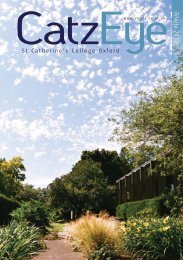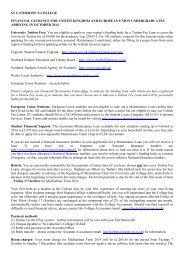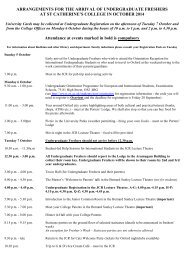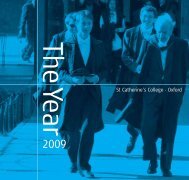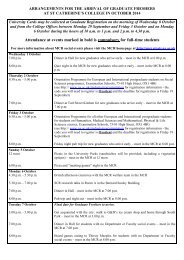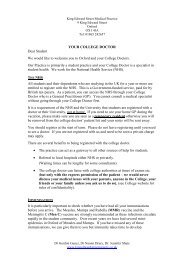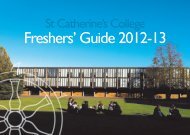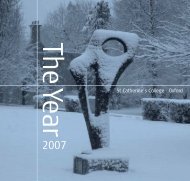Download PDF - St. Catherine's College - University of Oxford
Download PDF - St. Catherine's College - University of Oxford
Download PDF - St. Catherine's College - University of Oxford
Create successful ePaper yourself
Turn your PDF publications into a flip-book with our unique Google optimized e-Paper software.
CATZ RESEARCH<br />
Bart van Es Fellow & Tutor in English<br />
Earlier this term, Bart van Es marked the<br />
publication <strong>of</strong> his latest book, Shakespeare<br />
in Company, with a launch in the <strong>College</strong>’s<br />
Mary Sunley Building. Based on research<br />
into hundreds <strong>of</strong> manuscripts and plays by<br />
Shakespeare and his contemporaries, the<br />
book seeks to address how Shakespeare’s<br />
working conditions affected his artistic<br />
development.<br />
Bart van Es’s new book examines the way<br />
that Shakespeare’s plays were shaped by<br />
the influence <strong>of</strong> his contemporaries. It tells<br />
the story <strong>of</strong> how the playwright’s work was<br />
transformed by his decision in 1594 to become<br />
a shareholder in an acting company, a decision<br />
that would make him wealthier than any other<br />
playwright and would also give him a new<br />
kind <strong>of</strong> artistic control. Bart argues that it was<br />
above all the events <strong>of</strong> 1594 that separated<br />
Shakespeare from the literary mainstream.<br />
Close contact over many years with the<br />
same set <strong>of</strong> actors allowed the dramatist<br />
to develop what the book terms ‘relational’<br />
drama, in which a large group <strong>of</strong> characters<br />
retain consistent physical distinctiveness plus<br />
a ‘memory’ <strong>of</strong> what other characters have<br />
done. This kind <strong>of</strong> drama differed from that<br />
<strong>of</strong> Shakespeare’s contemporaries and had not<br />
been written before.<br />
Bart van Es’s book splits the playwright’s<br />
career into four phases. The first looks at<br />
Shakespeare’s life and work before he became<br />
a sharer. It argues that in early compositions<br />
like Titus Andronicus, the Henry VI plays, or<br />
The Rape <strong>of</strong> Lucrece Shakespeare’s style was<br />
very close to that <strong>of</strong> his contemporaries, such<br />
as Christopher Marlowe and George Peele.<br />
Using surviving letters and other manuscripts,<br />
Bart sets out the nature <strong>of</strong> everyday working<br />
practice in the early modern theatre. During<br />
this period Shakespeare collaborated closely<br />
with his fellow playwrights, <strong>of</strong>ten producing<br />
co-written plays.<br />
After 1594 Shakespeare’s working practice<br />
became very different, but the exact makeup<br />
<strong>of</strong> the acting company did not stay the<br />
same. The rest <strong>of</strong> the book charts these<br />
developments, showing how the arrival <strong>of</strong><br />
new actors and the purchase <strong>of</strong> the Globe<br />
playhouse had a direct impact on the way<br />
Shakespeare wrote. Rivalry with other acting<br />
companies is also part <strong>of</strong> this picture. Most<br />
important, there was competition with the<br />
new children’s theatres, which established<br />
themselves in the capital at the start <strong>of</strong><br />
the seventeenth century. The child actors,<br />
whom Hamlet calls ‘little eyases’, are directly<br />
addressed in Shakespeare’s drama. The<br />
52/BART VAN ES



